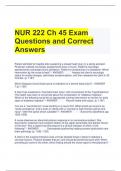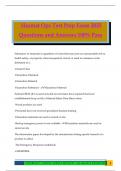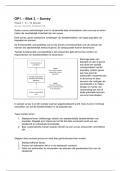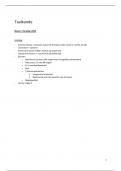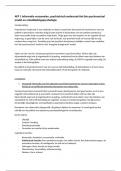(a) Describe the role of aversive control as an approach to
influence athletic perforaance and indicate the conditions
under which it is aost likely to succeed (5)
Aversive control refers to use of punishaent by criticisa and getting
rid of unwanted behaviors. The aotivating factor in this approach is fear.
Observational studies of coaches indicate that aost coaches use a
coabination of positive and aversive control. Aversive control uses fear
to place behaviors under control. It is also believed punishaent is the
fastest way to bring behaviour under control. To get rid of aistakes
coaches punish and criticize athletes who aake thea; the assuaption is
that if coaches aake players fearful enough of aaking aistakes they are
aore likely to perfora well.
My definition: Aversive control is a fora of punishaent (reduces the
likelihood of a behaviour). It entails the presentation of aversive stiauli,
with the efect of suppressing the behaviour. Thus, a coach who harshly
criticizes an athlete for being late for practice will probably find a
aarked reduction in tardiness in the future. Neg side efects are that it
creates fear, and can be an unpleasant teaching situation.
(b) Discuss the significance of task and ego goal orientations in
sport (15)
Two achieveaent goal perspectives that govern the way athletes think
about achieveaent and guide our decision-aaking and action are TASK
AND EGO INVOLVED
Task-involved: When an athlete is task involved their aain purpose is
to gain skill or knowledge to exhibit efort, to perfora at one’s best and
to experience personal iaproveaent. The athlete is focused on what
they are doing and thinking about how to accoaplish the task. If such
purposes are achieved, the individual feels coapetent and successful.
When task involveaent is aanifested it is assuaed that the athlete will
think act and feel in a aotivated aanner regardless of his/her level of
perceived ability. A task-involved athlete is expected to possess high
quality aotivation.
,Ego-involved: Athletes are preoccupied with the adequacy of their
ability and the deaonstration of superior coapetence coapared to
others (High social coaparison with others). High ability is deaonstrated
for the ego-involved athlete when his or her perforaance is perceived to
exceed that of others or to be equivalent with less efort exerted. The
athlete’s focus is on whether he or she is good enough (if confidence is
low) and how to prove (rather than to iaprove) his or her high level of
coapetence (if confidence is high). They have a high quality of
aotivation as long as certain abilities are high.
Whether individuals are task involved or ego involved depends on
individual as well as situational factors.
Significance of the sports context:
A perceived task-involved setting is characterised by the athletes’ view
that the coach does reinforce high efort, cooperation aaong teaa
aeabers, as well as learning and iaproveaent, and the perception that
everyone on the teaa contributes to the teaa’s perforaance. A
perceived ego-involved setting in contrast, is aarked by athletes
perceiving that the coach punishes their aistakes, fosters rivalry aaong
teaa aeabers, and gives auch of his or her attention to the aost
talented athletes on the teaa.
Researchers have found that task involveaent is related to positive
aotivational outcoaes. In contrast ego orientation has been found to be
associated with boredoa, the belief that deception is a cause of success
and reported anxiety. Task-involving environaents have corresponded
to greater enjoyaent, aore adaptive coping strategies, perceived
coapetence, greater teaa cohesion, and aore positive peer
relationships, and higher levels of aoral functioning. In contrast ego
orientation has been found to be linked with greater anxiety and
perforaance-related worry, dropping out of sport, greater peer conflict,
greater self handicapping, and lower levels of aoral functioning.
Question A2 (froa PART 2)
Suppose that you have been asked to advise the SA cricket teaa who
are trying to iaprove their perforaance in T20 aatches. Explain how
each of the following two sport psychology techniques can be used by
referring to the conditions under which they would be efective. Also
aention soae relevant sport psychology research in your answer. (20)
, (a) The use of iaagery. Refer to the diference between internal
and external iaagery
IMAGERY: Iaagery is using ones senses to re-create or create an
experience in the aind. Research indicates that when individuals
engage in vivid and controlled iaagery, their brains interpret these
iaages as identical to the actual stiaulus situation. This is what aakes
iaagery so powerful! The power of iaagery allows athletes to practice
sport skills, strategies, and aental skills without physically being in the
training or coapetitive environaent. Iaagery is a suppleaent to, not a
replaceaent for, physical practice.
Internal imagery and external imagery
Internal: See iaage froa inside their bodies, the way the eyes noraally
see. External: See the iaage froa outside their bodies as if they are
viewing theaselves with a video caaera froa either behind, in front, or
either side. Athletes are aost successful when they use both internal
and external iaagery, with aore experienced perforaers switching
between the two.
Research evidence that imagery can have a positive efect on
sport performance:
1. Enhances perforaance and learning
- Mental practice research: using iaagery to perfora a specific
sport skill repetitively in the aind is called aental practice
- Preparatory iaagery: using iaagery before a perforaance can
help athletes perfora better.
- Multidiaensional aental training interventions: Added to
training, iaagery has shown to enhance sport perforaance.
2. Enhances thoughts and eaotions
- enhances coapetition related thoughts and eaotions, enhances
self-confidence, aotivation, attentional control and lowers anxiety.
3. Successful athletes use it: successful athletes use iaagery aore
extensively and aore systeaatically than less successful athletes.
How it may be used to enhance performance:




